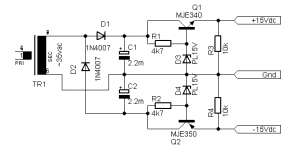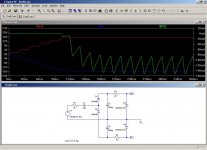Hi everybody!
I'm repairing an old Lab Power Supply right now. It used to have some weird current sourcing/sinking used in the power supply. I already completely "modernized" the control circuit using JFET current sources etc. so my design only needs +/-15V supply. But i want to keep the original transformer that puts out a single 50V supply. So my question is: what is the best solution to convert 50V to +/-15V? I already thought of two zeners and a resistor, two cascaded 7815 (altough there would be a problem of too high input voltage) or regulation to 30V and using a rail splitter… What do you think is the best? Or is there something better?
Thanks in advance!
I'm repairing an old Lab Power Supply right now. It used to have some weird current sourcing/sinking used in the power supply. I already completely "modernized" the control circuit using JFET current sources etc. so my design only needs +/-15V supply. But i want to keep the original transformer that puts out a single 50V supply. So my question is: what is the best solution to convert 50V to +/-15V? I already thought of two zeners and a resistor, two cascaded 7815 (altough there would be a problem of too high input voltage) or regulation to 30V and using a rail splitter… What do you think is the best? Or is there something better?
Thanks in advance!
How much current is needed for that +/-15V? Does the transformer has an 50Vac output or those 50V are after rectifyer and filter cap?
50V after filter cap. The +/-15V rails have to supply power to four opamps (TL074) so i think no more than 100mA are needed.
Ok then, you can go either with a floating ground or with voltage doubler, witch one seams more to your liking?
similar discussions here:
http://www.diyaudio.com/forums/power-supplies/219974-how-split-single-40v-into-15v-2.html
and here:
http://www.diyaudio.com/forums/power-supplies/229503-15vdc-7815-7915-power-supply.html
doubler is technically O.K. and probably best, but since you already have a high voltage it doesn't seem reasonable to go to 100v first ...
QUAD used a capacitive splitter w/o doubler in their 606 amp to obtain +/-V and virtual gnd from single DC
— Why not buy Keith Snook a BEER —
note T15 / T16 device to keep balance
http://www.diyaudio.com/forums/power-supplies/219974-how-split-single-40v-into-15v-2.html
and here:
http://www.diyaudio.com/forums/power-supplies/229503-15vdc-7815-7915-power-supply.html
doubler is technically O.K. and probably best, but since you already have a high voltage it doesn't seem reasonable to go to 100v first ...
QUAD used a capacitive splitter w/o doubler in their 606 amp to obtain +/-V and virtual gnd from single DC
— Why not buy Keith Snook a BEER —
note T15 / T16 device to keep balance
I read those threads but thats not exactly what i'm searching for. The problem that bugs me most is the quite high voltage from the transformer. If i had a 15 to 20V winding, i would just use the voltage doubler design seen everywhere. But 50V is too high for feeding 78XX regulators. So i dont think a voltage doubler would make sense in this case. I think the most desireable solution is to use two 15V zeners and a resistor? What do you think?
A dual-output capacitive supply with 15V zeners seems like the most reasonable solution.
That won't waste too much power.
That won't waste too much power.
I am not a verry big fan of the virtual ground ideea, it might create problems when connected to other fix grounded circuits... i think voltage doubler would be better, 50Vdc means about 35Vac from the power transformer, and with voltage doubler about +/-50Vdc, a zenner diode each rail helped by a BJT would do just nicely.
I am not a verry big fan of the virtual ground ideea, it might create problems when connected to other fix grounded circuits...
Why?
He has a transformer in there...
Its still floating isnt it?
That is just a voltage doubler, and what i have sugested...
PS: What use do you have for R1 and C1?
PS: What use do you have for R1 and C1?
One easy solution would be a simple DC-DC converter designed for telecom use. They're 48 Vdc in and you can choose the desired output voltages. They usually will tolerate 36-72 volts on the input.
It would become a voltage doubler if it happened to be operated open circuit, which is normally never the case.That is just a voltage doubler, and what i have sugested...
PS: What use do you have for R1 and C1?
R1 limits current spikes, at power on for instance, and C1 sets the average output current. Each cycle, it transfers a charge of C1*2*Vpeak to one of the outputs, leading to an average current of Q*Fmains, 50Hz in this case.
- Status
- Not open for further replies.
- Home
- Amplifiers
- Power Supplies
- 50V to +/-15 - Best solution?

